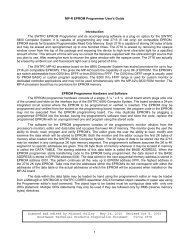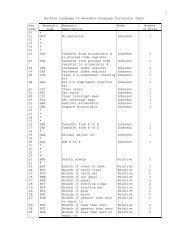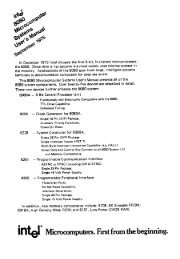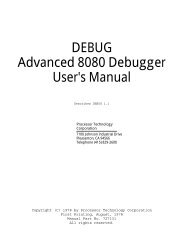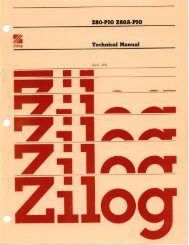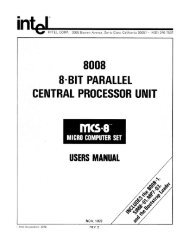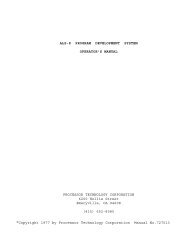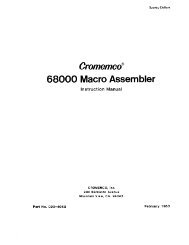The System Manual of SOL-20 - History of Computers
The System Manual of SOL-20 - History of Computers
The System Manual of SOL-20 - History of Computers
Create successful ePaper yourself
Turn your PDF publications into a flip-book with our unique Google optimized e-Paper software.
PROCESSOR TECHNOLOGY CORPORATION<br />
Sol THEORY OF OPERATION<br />
SECTION VIII<br />
PXDR on pin 16 <strong>of</strong> J2 is supplied by the external device. It<br />
indicates the device is ready to receive data. !PXDR is buffered to<br />
INT2 and will effect the transfer <strong>of</strong> data to the Internal Data Bus<br />
during the status input to the CPU. !PXDR is analogous to the previously<br />
discussed PIAK signal.<br />
Sense Switches S2-1 through 8 are driven by !PORT_IN_FF when<br />
it is low. Thus, the DIO lines connected to closed switches are<br />
driven low, and those connected to open switches are pulled high.<br />
U97 (a 4-bit D-type register) and one section <strong>of</strong> U52 (a J-!K<br />
flip-flop connected as a D flip-flop) latch five bits <strong>of</strong> data on<br />
D103-7 when !PORT_OUT_FA goes active. <strong>The</strong>se bits, which supply the<br />
indicated outputs, control conditions in both the PP and CDI. With<br />
respect to the PP, PIE enables parallel input, and PUS selects the<br />
parallel device for the transfer. <strong>The</strong> data in these two latches remains<br />
until either a new word is read out or POC goes active.<br />
Also during !PORT_OUT_FA, the keyboard flag is reported.<br />
!KEYBOARD_DATA_READY on pin 3 <strong>of</strong> J3 is a low going pulse 1 to 10 usec<br />
in duration. It is applied to pin 13 <strong>of</strong> J-!K flip-flop U70. Some<br />
time after pin 13 <strong>of</strong> U70 goes low, but before 500 nsec, U70 is set<br />
by φ2 and pin 10 goes low. This low is buffered through U71 to INT0<br />
to indicate the keyboard is ready to send data. Reset <strong>of</strong> U70 occurs<br />
with a POC or by !PORT_IN_FC. <strong>The</strong> latter occurs when data is accepted<br />
from the keyboard.<br />
<strong>The</strong> other half <strong>of</strong> flip-flop U52, with its output on pin 6,<br />
latches one bit <strong>of</strong> status, D104, when !PORT_OUT_F8 is active. Its<br />
output is applied to pin 5 <strong>of</strong> one operational amplifier section in<br />
U56 to become the SRTS (request to send) signal on pin 4 <strong>of</strong> J1, the<br />
SDI connector.<br />
<strong>The</strong> SDI/UART centers around a UART, U51. <strong>The</strong> UART transmission<br />
conditions (parity, word length and stop bits) are determined by<br />
the settings <strong>of</strong> S4-1 through 5. (Refer to Paragraphs 7.5.8 through<br />
7.5.10 in Section VII for descriptions <strong>of</strong> the switch settings and<br />
their effect on transmission.<br />
Data destined to leave Sol through the SDI/UART enters the<br />
UART on its TI1-6 inputs from the Bidirectional Data Bus when TBRL<br />
(pin 23) is low; that is, when !PORT_OUT_F9 goes active. Circuitry<br />
within the UART serializes the input data, which is in parallel form,<br />
and outputs it on pin 25 at a rate determined by the clock on pin 40.<br />
<strong>The</strong> binary states at pin 25 are low for a zero and high for a one.<br />
Assuming Sol is not in local operation ("<strong>of</strong>f line"), the output on<br />
pin 25 <strong>of</strong> the UART is applied to pins 2 and 11 <strong>of</strong> J1 via two gates in<br />
U55 and the other half <strong>of</strong> U56.<br />
VIII-19



